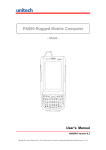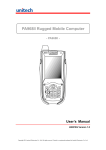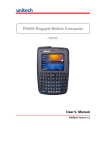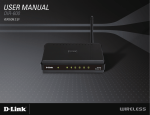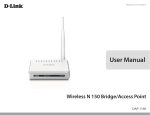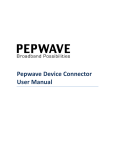Download D-Link DAP-1513 User manual
Transcript
Table of Contents Table of Contents Product Overview............................................................... 3 Package Contents.......................................................................... 3 System Requirements.................................................................. 4 Introduction.................................................................................... 5 Features............................................................................................. 7 Hardware Overview...................................................................... 8 Connections............................................................................ 8 LEDs............................................................................................ 9 WPS Button............................................................................10 Installation........................................................................11 Wireless Installation Considerations.....................................12 Configuration....................................................................13 First Time Setup............................................................................13 Web-based Configuration Utility...........................................17 Wireless Setup Wizard................................................................18 Manual Configuration................................................................19 Wireless Setup.......................................................................19 LAN Settings..........................................................................20 Static IP...............................................................................21 Advanced.......................................................................................22 Advanced Wireless..............................................................22 Maintenance.................................................................................23 Admin......................................................................................23 System.....................................................................................24 Language Pack......................................................................25 Firmware.................................................................................25 D-Link DAP-1513 User Manual Time..........................................................................................26 Status...............................................................................................27 Device Info.............................................................................27 Logs..........................................................................................28 Statistics..................................................................................29 Help..................................................................................................30 Wireless Security..............................................................31 What is WPA?.................................................................................32 Configure WPA/WPA2 Personal..............................................33 Troubleshooting...............................................................34 Networking Basics............................................................36 Check your IP address................................................................36 Statically Assign an IP address................................................37 Technical Specifications...................................................38 Contacting Technical Support.........................................39 Warranty............................................................................40 Registration......................................................................46 2 Section 1 - Product Overview Product PackageOverview Contents DAP-1513 Wireless N Dual Band MediaBridge® Ethernet Cable Power Adapter CD-ROM with Manual Note: Using a power supply with a different voltage rating than the one included with the DAP-1513 will cause damage and void the warranty for this product. D-Link DAP-1513 User Manual 3 Section 1 - Product Overview System Requirements Network Requirements • An Ethernet-based Network • IEEE 802.11n/g wireless MediaBridge® or wireless router • 10/100 Ethernet Computer with the following: • Windows®, Macintosh, or Linux-based operating system • An installed Ethernet adapter Web-based Configuration Utility Requirements Browser Requirements: • Internet Explorer® 6.0 and higher • Mozilla Firefox 3.0 and higher • Google™ Chrome 2.0 and higher • Apple Safari 3.0 and higher Windows® Users: Make sure you have the latest version of Java installed. Visit www.java.com to download the latest version. D-Link DAP-1513 User Manual 4 Section 1 - Product Overview Introduction D-Link, an industry leader in networking, introduces the new D-Link DAP-1513 Wireless N Dual Band MediaBridge®. With the ability to transfer files with a maximum wireless signal rate of up to 300Mbps*, the DAP-1513 gives you high-speed wireless network access for your home or office. The DAP-1513 is Wi-Fi IEEE 802.11n compliant, meaning that it can connect and interoperate with other 802.11n compatible wireless client devices. The DAP-1513 is also backwards compatible with 802.11b/g and offers dual band support for 802.11a. With its Setup Wizard, the DAP-1513 ensures that you will be up and running on a wireless network in just a matter of minutes. The DAP-1513 features Wi-Fi Protected Access (WPA-PSK/WPA2-PSK) to provide an enhanced level of security for wireless data communications. The DAP-1513 also includes additional security features to keep your wireless connection safe from unauthorized access. • Actual data throughput will vary. Network conditions and environmental factors, including volume of network traffic, building materials and construction, and network overhead, lower actual data throughput rate. D-Link DAP-1513 User Manual 5 Section 1 - Product Overview TOTAL PERFORMANCE Combines award winning MediaBridge® features and 802.11n wireless technology to provide the best wireless performance. TOTAL SECURITY The most complete set of security features including WPA/WPA2 encryption to protect your network against outside intruders. TOTAL COVERAGE Provides greater wireless signal rates even at farther distances for best-in-class home coverage. TOTAL NETWORK SECURITY The DAP-1513 supports all of the latest wireless security features to prevent unauthorized access, be it from over the wireless network or from the Internet. Support for WPA and WPA2 standards ensure that you’ll be able to use the best possible encryption method, regardless of your client devices. * Maximum wireless signal rate derived from IEEE Standard 802.11g and 802.11n specifications. Actual data throughput will vary. Network conditions and environmental factors, including volume of network traffic, building materials and construction, and network overhead, lower actual data throughput rate. Environmental conditions will adversely affect wireless signal range. D-Link DAP-1513 User Manual 6 Section 1 - Product Overview Features • Faster Wireless Networking - The DAP-1513 provides up to 300Mbps* wireless connection with other 802.11n wireless devices. This capability allows users to participate in real-time activities online, such as video streaming, online gaming, and real-time audio. • Compatible with IEEE 802.11g Devices - The DAP-1513 is still fully compatible with the 802.11g standards, so it can connect with existing 802.11g PCI, USB, and Cardbus adapters. • WPS PBC - (Wi-Fi Protected Setup Push Button Configuration) Push Button Configuration is a button that can be pressed to add the device to an existing network or to create a new network. A virtual button can be used on the utility while a physical button is placed on the side of the device. This easy setup method allows you to form a secured wireless link between the DAP-1513 and another WPS enabled device. A PC is no longer needed to log into the Web-based interface. • WPS PIN - (Wi-Fi Protected Setup Personal Identification Number ) A PIN is a unique number that can be used to add the MediaBridge® to an existing network or to create a new network. The default PIN may be printed on the bottom of the MediaBridge® . For extra security, a new PIN can be generated. You can restore the default PIN at any time. Only the Administrator (“Admin” account) can change or reset the PIN. • User-friendly Setup Wizard - Through its easy-to-use Web-based user interface, the DAP-1513 lets you configure your MediaBridge® to your specific settings within minutes. D-Link DAP-1513 User Manual 7 Section 1 - Product Overview Hardware Overview Connections 1 2 3 1 LAN Ports (1-4) Connect 10/100 Ethernet devices such as computers, cameras, and NAS (Network-Attached Storage). 2 Power Receptor Receptor for the supplied power adapter. 3 Reset Button D-Link DAP-1513 User Manual Hold the reset button for at least 6 seconds to reset the device back to the factory default settings. All the LEDs will turn on for 2 second and then begin the reboot process. 8 Section 1 - Product Overview Hardware Overview LEDs 1 2 1 Power LED 2 Wireless LED D-Link DAP-1513 User Manual A solid green light indicates a proper connection to the power supply. A static green light indicates a successful wireless connection. The light will blink fast when the WPS is associating. The light will be off during device reboot. 9 Section 1 - Product Overview Hardware Overview WPS Button 1 1 WPS/Button D-Link DAP-1513 User Manual Press the WPS button to start the process. You will have 120 seconds to start the WPS process on another wireless device. The Power LED will blink on and off when the WPS button is pressed. 10 Section 2 - Installation Installation The DAP-1513 acts as a wireless network bridge for your Ethernet-enabled device (such as a game console or a TV set-top box). Connect your Ethernet-enabled device to the MediaBridge using Ethernet cables. The DAP-1513 MediaBridge can support up to 4 wired devices. Additional devices can be added by connecting an Ethernet switch. Example: Connect a gaming console using an Ethernet cable to the DAP-1513. The unit is set to Wireless bridge which will wirelessly connect to a wireless router on your network. Gaming Console Internet Modem D-Link DAP-1513 User Manual Router DAP-1513 11 Section 2 - Installation Wireless Installation Considerations The D-Link wireless MediaBridge® lets you access your network using a wireless connection from virtually anywhere within the operating range of your wireless network. Keep in mind, however, that the number, thickness and location of walls, ceilings, or other objects that the wireless signals must pass through, may limit the range. Typical ranges vary depending on the types of materials and background RF (radio frequency) noise in your home or business. The key to maximizing wireless range is to follow these basic guidelines: 1.Keep the number of walls and ceilings between the D-Link MediaBridge® and other network devices to a minimum. Each wall or ceiling can reduce your adapter’s range from 3-90 feet (1-30 meters.) Position your devices so that the number of walls or ceilings is minimized. 2.Be aware of the direct line between network devices. A wall that is 1.5 feet thick (.5 meters), at a 45-degree angle appears to be almost 3 feet (1 meter) thick. At a 2-degree angle it looks over 42 feet (14 meters) thick! Position devices so that the signal will travel straight through a wall or ceiling (instead of at an angle) for better reception. 3.Building Materials make a difference. A solid metal door or aluminum studs may have a negative effect on range. Try to position MediaBridge®, wireless access points, and computers so that the signal passes through drywall or open doorways. Materials and objects such as glass, steel, metal, walls with insulation, water (fish tanks), mirrors, file cabinets, brick, and concrete will degrade your wireless signal. 4.Keep your product away (at least 3-6 feet or 1-2 meters) from electrical devices or appliances that generate RF noise. 5.If you are using 2.4GHz cordless phones or X-10 (wireless products such as ceiling fans, lights, and home security systems), your wireless connection may degrade dramatically or drop completely. Make sure your 2.4GHz phone base is as far away from your wireless devices as possible. The base transmits a signal even if the phone is not in use. D-Link DAP-1513 User Manual 12 Section 3 - Configuration Configuration This section will show you how to configure your new D-Link wireless MediaBridge® using the web-based configuration utility. First Time Setup Click Next to continue. The DAP-1513 is in wireless bridge mode. Click Next to continue. D-Link DAP-1513 User Manual 13 Section 3 - Configuration If you have a Wi-Fi Protected Setup (WPS)-enabled wireless router or Access Point, select WPS and click Next to continue. If you want to manually enter the network settings, select Manual and click Next to continue. Skip to page 17. On the device you want to connect to, start the PBC process on the device. You will have 2 minutes to start the PBC process on both devices. D-Link DAP-1513 User Manual 14 Section 3 - Configuration Select Manual configuration to setup your network manually. Click Next to continue. Enter the network name (SSID) of the network you want to connect to. If you do not know the exact name or would like to search for the wireless network, click Site Survey. Find your wireless router or access point from the list, click the radio button in the right column, and click Connect. D-Link DAP-1513 User Manual 15 Section 3 - Configuration Select the wireless security mode you would like to use. If you select WPA or WPA2, enter the wireless security password. Click Next to complete the Setup Wizard. The Setup Wizard is complete. Click Finish to reboot the device. D-Link DAP-1513 User Manual 16 Section 3 - Configuration Web-based Configuration Utility If you wish to change the default settings or optimize the performance of the DAP-1513, you may use the web-based configuration utility. To access the configuration utility, open a web browser such as Internet Explorer and enter http://dlinkap or http:// 192.168.0.50 in the address field. Type Admin and then enter your password. Leave the password blank by default. If you get a Page Cannot be Displayed error, please refer to the Troubleshooting section for assistance. D-Link DAP-1513 User Manual 17 Section 3 - Configuration Wireless Setup Wizard Click Launch Wireless Setup Wizard to configure your wireless bridge. Refer to the First Time Setup section for the Wireless Setup Wizard. If you want to enter your settings without running the wizard, click Wireless Setup on the left side and skip to the next page. D-Link DAP-1513 User Manual 18 Section 3 - Configuration Manual Configuration Wireless Setup Wireless Mode: Bridge Mode only. Site Survey: Click Site Survey to display a list of wireless networks in your area. You may select the wireless router or access point to connect to. Wireless Network Enter the SSID of the access point or wireless router Name: you want to connect to. If you do not know for sure, click Site Survey and select it from the list, if available. Wireless Channel: The channel will automatically change to the channel of the AP you are connected to. 802.11 Mode: Select the appropriate 802.11 mode based on the wireless clients in your network. The drop-down menu options are 802.11g Only, Mixed 802.11b/g, 802.11b Only, 802.11n Only, or Mixed 802.11b/g/n. Channel Width: Select the appropriate channel width between 20MHz or Auto 20/40MHz from the drop-down Wireless MAC Clone: menu. Wireless Security You can clone the wireless MAC address to connect Mode: the device. WPS: Select a wireless security setting. Options are None, WEP, WPA, or WPA2. See the Wireless Security section in this manual for a detailed explanation of the wireless security options. Select enable if you want to configure the DAP-1513 with Wi-Fi Protection setup. D-Link DAP-1513 User Manual 19 Section 3 - Configuration LAN Settings This section will allow you to change the local network settings of the MediaBridge® and to configure the DHCP settings. LAN Connection Use the drop-down menu to select Dynamic IP Type: (DHCP) to automatically obtain an IP address on the LAN/private network. Device Name: Enter the Device Name of the DAP-1513. It is recommended to change the Device Name if there is more than one D-Link device within the subnet. D-Link DAP-1513 User Manual 20 Section 3 - Configuration Static IP Select Static IP Address if all the Internet port’s IP information is provided to you by your ISP. You will need to enter in the IP address, subnet mask, gateway address, and DNS address(es) provided to you by your ISP. Each IP address entered in the fields must be in the appropriate IP form, which are four octets separated by a dot (x.x.x.x). The MediaBridge® will not accept the IP address if it is not in this format. LAN Connection Type: Select Static IP from the drop-down menu. IP Address: Enter the IP address of the MediaBridge®. The default IP address is 192.168.0.50. If you change the IP address, once you click Apply, you will need to enter the new IP address in your browser to get back into the configuration utility. Subnet Mask: Enter in the Subnet Mask. Default Gateway: Enter the Gateway. Device Name: Enter the Device Name of the DAP-1513. It is recommended to change the Device Name if there is more than one D-Link device within the subnet. You can enter the device name of the AP into your web browser to access the instead of IP address for configuration. If you are using the device name to connect, ensure that your PC and your DAP-1513 are on the same network. D-Link DAP-1513 User Manual 21 Section 3 - Configuration Advanced Advanced Wireless Transmit Power: Sets the transmit power of the antennas. D-Link DAP-1513 User Manual 22 Section 3 - Configuration Maintenance Admin This page will allow you to change the Administrator password. The administrator password has read/write access. Password: Enter a new password for the Administrator Login Name. The administrator can make changes to the settings. Verify Enter the same password that you entered in the Password: previous textbox in order to confirm its accuracy. Enable Enables a challenge-response test to require users Graphical to type letters or numbers from a distorted image Authentication: displayed on the screen to prevent online hackers and unauthorized users from gaining access to your router’s network settings. D-Link DAP-1513 User Manual 23 Section 3 - Configuration System Save to Local Use this option to save the current MediaBridge® Hard Drive: configuration settings to a file on the hard disk of the computer you are using. Click the Save button. You will then see a file dialog where you can select a location and file name for the settings. Upload from Use this option to load previously saved MediaBridge® Local Hard Drive: configuration settings. Click Browse to find a previously saved configuration file. Then, click the Upload Settings button to transfer those settings to the MediaBridge®. Restore to This option will restore all configuration settings Factory Default: back to the settings that were in effect at the time the MediaBridge® was shipped from the factory. Any settings that have not been saved will be lost, including any rules that you have created. If you want to save the current MediaBridge® configuration settings, use the Save button above. Note: Restoring the factory default settings will not reset the Wi-Fi Protected Status to Not Configured. Reboot the Click to reboot the DAP-1513. Device: D-Link DAP-1513 User Manual 24 Section 3 - Configuration Firmware You can upgrade the firmware of the MediaBridge® here. Make sure the firmware you want to use is on the local hard drive of the computer. Click on Browse to locate the firmware file to be used for the update. Please check the D-Link support website for firmware updates at http://support.dlink.com. You can download firmware upgrades to your hard drive from this site. Browse: After you have downloaded the new firmware, click Browse to locate the firmware update on your hard drive. Click Upload to complete the firmware upgrade. Upload: Once you have a firmware update on your computer, use this option to browse for the file and then upload the information into the MediaBridge®. Language Pack You can change the language of the web UI by uploading available language packs. Browse: After you have downloaded the new language pack, click Browse to locate the language pack file on your hard drive. Click Upload to complete the language pack upgrade. D-Link DAP-1513 User Manual 25 Section 3 - Configuration Time The Time Configuration option allows you to configure, update, and maintain the correct time on the internal system clock. From this section you can set the time zone that you are in. Daylight Saving can also be configured to automatically adjust the time when needed. Time Zone: Select the Time Zone from the drop-down menu. Daylight Saving: To select Daylight Saving time manually, click the Enable Daylight Saving check box. Next use the drop-down menu to select a Daylight Saving Offset and then enter a start date and an end date for daylight saving time. Enable NTP NTP is short for Network Time Protocol. NTP Server: synchronizes computer clock times in a network of computers. Check this box to use a NTP server. This will only connect to a server on the Internet, not a local server. NTP Server Used: Enter the NTP server or select one from the drop-down menu. Date and Time: To manually input the time, enter the values in these fields for the Year, Month, Day, Hour, Minute, and Second and then click Save Settings. You can also click the Copy Your Computer’s Time Settings button at the bottom of the screen. D-Link DAP-1513 User Manual 26 Section 3 - Configuration Status Device Info This page displays the current information for the DAP-1513. It will display the LAN and wireless LAN information. General: Displays the MediaBridge® time and firmware version. LAN: Displays the MAC address and the private (local) IP settings for the MediaBridge®. Wireless LAN: Displays the wireless MAC address and your wireless settings such as SSID and Channel. D-Link DAP-1513 User Manual 27 Section 3 - Configuration Logs The DAP-1513 keeps a running log of events and activities occurring on the AP. If the AP is rebooted, the logs are automatically cleared. You can save the log files under Log Setting. First Page: This button directs you to the first page of the log. Last Page: This button directs you to the last page of the log. Previous Page: This button directs you to the previous page of the log. Next Page: This button directs you to the next page of the log. Clear Log: This button clears all current log content. Save Log: This option will save the MediaBridge® to a log file on your computer. Refresh: This button refreshes the log. D-Link DAP-1513 User Manual 28 Section 3 - Configuration Statistics The DAP-1513 keeps statistics of the traffic that passes through it. You can view the amount of packets that pass through the LAN and wireless portions of the network. The traffic counter will reset if the MediaBridge® is rebooted. D-Link DAP-1513 User Manual 29 Section 3 - Configuration Help D-Link DAP-1513 User Manual 30 Section 4 - Security Wireless Security This section will show you the different levels of security you can use to protect your data from intruders. The DAP-1513 offers the following types of security: • WPA2 (Wi-Fi Protected Access 2) • WPA (Wi-Fi Protected Access) D-Link DAP-1513 User Manual • WPA2-PSK (Pre-Shared Key) • WPA-PSK (Pre-Shared Key) 31 Section 4 - Security What is WPA? WPA, or Wi-Fi Protected Access, is a Wi-Fi standard that was designed to improve the security features of WEP (Wired Equivalent Privacy). The 2 major improvements over WEP: • Improved data encryption through the Temporal Key Integrity Protocol (TKIP). TKIP scrambles the keys using a hashing algorithm and, by adding an integrity-checking feature, ensures that the keys haven’t been tampered with. WPA2 is based on 802.11i and uses Advanced Encryption Standard (AES) instead of TKIP. • User authentication, which is generally missing in WEP, through the extensible authentication protocol (EAP). WEP regulates access to a wireless network based on a computer’s hardware-specific MAC address, which is relatively simple to be sniffed out and stolen. EAP is built on a more secure public-key encryption system to ensure that only authorized network users can access the network. WPA-PSK/WPA2-PSK uses a passphrase or key to authenticate your wireless connection. The key is an alpha-numeric password between 8 and 63 characters long. The password can include symbols (!?*&_) and spaces. This key must be the exact same key entered on your wireless bridge or MediaBridge® . WPA/WPA2 incorporates user authentication through the Extensible Authentication Protocol (EAP). EAP is built on a more secure public key encryption system to ensure that only authorized network users can access the network. D-Link DAP-1513 User Manual 32 Section 4 - Security Configure WPA/WPA2 Personal It is recommended to enable encryption on your wireless MediaBridge® before your wireless network adapters. Please establish wireless connectivity before enabling encryption. Your wireless signal may degrade when enabling encryption due to the added overhead. 1.Log into the web-based configuration by opening a web browser and entering the IP address of the MediaBridge®(192.168.0.50). Click on Setup and then click Wireless Setup on the left side. 2.Next to Security Mode, select WPA Personal. 3. Next to WPA Mode, select Auto WPA or WPA2. 4.Next to Cipher Type, select TKIP or AES. 5.Next to Pre-Shared Key, enter a key. The key is entered as a passphrase in ASCII format at both ends of the wireless connection. The passphrase must be between 8-63 characters. 6.Click Save Settings at the top of the window to save your settings. If you are configuring the MediaBridge® with a wireless adapter, you will lose connectivity until you enable WPA-PSK on your adapter and enter the same passphrase as you did on the MediaBridge®. D-Link DAP-1513 User Manual 33 Section 6 - Troubleshooting Troubleshooting This chapter provides solutions to problems that can occur during the installation and operation of the DAP-1513. Read the following descriptions if you are having problems. (The examples below are illustrated in Windows® XP. If you have a different operating system, the screenshots on your computer will look similar to the following examples.) 1. Why can’t I access the web-based configuration utility? When entering the IP address of the D-Link MediaBridge® (192.168.0.50 for example), you are not connecting to a website on the Internet or have to be connected to the Internet. The device has the utility built-in to a ROM chip in the device itself. Your computer must be on the same IP subnet to connect to the web-based utility. • Make sure you have an updated Java-enabled web browser. We recommend the following: - Microsoft Internet Explorer® 6.0 and higher - Mozilla Firefox 3.0 and higher - Google™ Chrome 2.0 and higher - Apple Safari 3.0 and higher • Verify physical connectivity by checking for solid link lights on the device. If you do not get a solid link light, try using a different cable or connect to a different port on the device if possible. If the computer is turned off, the link light may not be on. • Disable any internet security software running on the computer. Software firewalls such as Zone Alarm, Black Ice, Sygate, Norton Personal Firewall, and Windows® XP firewall may block access to the configuration pages. Check the help files included with your firewall software for more information on disabling or configuring it. D-Link DAP-1513 User Manual 34 Section 6 - Troubleshooting • Configure your Internet settings: • Go to Start > Settings > Control Panel. Double-click the Internet Options Icon. From the Security tab, click the button to restore the settings to their defaults. • Click the Connection tab and set the dial-up option to Never Dial a Connection. Click the LAN Settings button. Make sure nothing is checked. Click OK. • Go to the Advanced tab and click the button to restore these settings to their defaults. Click OK three times. • Close your web browser (if open) and open it. • Access the web management. Open your web browser and enter the IP address of your D-Link MediaBridge® in the address bar. This should open the login page for your the web management. • If you still cannot access the configuration, unplug the power to the MediaBridge® for 10 seconds and plug back in. Wait about 30 seconds and try accessing the configuration. If you have multiple computers, try connecting using a different computer. 2. What can I do if I forgot my password? If you forgot your password, you must reset your MediaBridge®. Unfortunately this process will change all your settings back to the factory defaults. To reset the MediaBridge®, locate the reset button (hole) on the rear panel of the unit. With the MediaBridge®powered on, use a paperclip to hold the button down for 10 seconds. Release the button and the MediaBridge® will go through its reboot process. Wait about 30 seconds to access the MediaBridge®. The default IP address is 192.168.0.50. When logging in, the username is Admin and leave the password box empty. D-Link DAP-1513 User Manual 35 Appendix B - Networking Basics Networking Basics Check your IP address After you install your adapter, by default, the TCP/IP settings should be set to obtain an IP address from a DHCP server (i.e. wireless router) automatically. To verify your IP address, please follow the steps below. Click on Start > Run. In the run box type cmd and click OK. (Windows® 7/Vista® users type cmd in the Start Search box.) At the prompt, type ipconfig and press Enter. This will display the IP address, subnet mask, and the default gateway of your adapter. If the address is 0.0.0.0, check your adapter installation, security settings, and the settings on your router. Some firewall software programs may block a DHCP request on newly installed adapters. D-Link DAP-1513 User Manual 36 Appendix B - Networking Basics Statically Assign an IP address If you are not using a DHCP capable gateway/router, or you need to assign a static IP address, please follow the steps below: Step 1 Windows® 7 - Click on Start > Control Panel > Network and Internet > Network and Sharing Center > Change Adapter Setting. ® Windows Vista - Click on Start > Control Panel > Network and Internet > Network and Sharing Center > Manage Network Connections. ® Windows XP - Click on Start > Control Panel > Network Connections. Windows® 2000 - From the desktop, right-click My Network Places > Properties. Step 2 Right-click on the Local Area Connection which represents your network adapter and select Properties. Step 3 Highlight Internet Protocol (TCP/IP) and click Properties. Step 4 Click Use the following IP address and enter an IP address that is on the same subnet as your network or the LAN IP address on your router. Example: If the router´s LAN IP address is 192.168.0.1, make your IP address 192.168.0.X where X is a number between 2 and 99. Make sure that the number you choose is not in use on the network. Set Default Gateway the same as the LAN IP address of your router (192.168.0.1). Set Primary DNS the same as the LAN IP address of your router (192.168.0.1). The Secondary DNS is not needed or you may enter a DNS server from your ISP. Step 5 Click OK twice to save your settings. D-Link DAP-1513 User Manual 37 Appendix C - Technical Specifications Technical Specifications Standards • IEEE 802.11n • IEEE 802.11g • IEEE 802.11a • IEEE 802.3 • IEEE 802.3u Security • WEP • WPA/WPA2-Personal • Wi-Fi Protected Setup (WPS PBC/PIN) Wireless Signal Rates1 • 300Mbps • 108Mbps • 54Mbps • 48Mbps • 36Mbps • 24Mbps • 18Mbps • 12Mbps • 11Mbps • 9Mbps • 6Mbps • 5.5Mbps • 2Mbps • 1Mbps Maximum Operating Voltage • 3.3V Maximum Power Consumption • 950 mA Modulation • DQPSK • DBPSK • CCK • OFDM Frequency Range2 • 2.4GHz to 2.483GHz • 5.15GHz to 5.825GHz LEDs • Power • Wireless Operating Temperature • 32°F to 131°F ( 0°C to 55°C) Humidity • 90% maximum (non-condensing) Safety & Emissions • FCC • IC • CE • C-Tick Dimensions • 142 (W) x 122 (D) x 29 (H) mm (5.6 x 4.8 x 1.14 inches) Maximum wireless signal rate derived from IEEE Standard 802.11g and 802.11n specifications. Actual data throughput will vary. Network conditions and environmental factors, including volume of network traffic, building materials and construction, and network overhead, lower actual data throughput rate. Environmental conditions will adversely affect wireless signal range. 2 Range varies depending on country’s regulation. 1 D-Link DAP-1513 User Manual 38 Appendix E - Warranty Warranty Federal Communication Commission Interference Statement This equipment has been tested and found to comply with the limits for a Class B digital device, pursuant to Part 15 of the FCC Rules. These limits are designed to provide reasonable protection against harmful interference in a residential installation. This equipment generates, uses and can radiate radio frequency energy and, if not installed and used in accordance with the instructions, may cause harmful interference to radio communications. However, there is no guarantee that interference will not occur in a particular installation. If this equipment does cause harmful interference to radio or television reception, which can be determined by turning the equipment off and on, the user is encouraged to try to correct the interference by one of the following measures: - Reorient or relocate the receiving antenna. - Increase the separation between the equipment and receiver. - Connect the equipment into an outlet on a circuit different from that to which the receiver is connected. - Consult the dealer or an experienced radio/TV technician for help. This device complies with Part 15 of the FCC Rules. Operation is subject to the following two conditions: (1) This device may not cause harmful interference, and (2) this device must accept any interference received, including interference that may cause undesired operation. FCC Caution: Any changes or modifications not expressly approved by the party responsible for compliance could void the user’s authority to operate this equipment. IEEE 802.11b or 802.11g operation of this product in the U.S.A. is firmware-limited to channels 1 through 11. IMPORTANT NOTE: FCC Radiation Exposure Statement: This equipment complies with FCC radiation exposure limits set forth for an uncontrolled environment. This equipment should be installed and operated with minimum distance 20cm between the radiator & your body. This transmitter must not be co-located or operating in conjunction with any other antenna or transmitter. D-Link DAP-1513 User Manual 39 Appendix E - Warranty Industry Canada Statement This device complies with RSS-210 of the Industry Canada Rules. Operation is subject to the following two conditions: 1) this device may not cause interference and 2) this device must accept any interference, including interference that may cause undesired operation of the device This device has been designed to operate with an antenna having a maximum gain of 2dBi. Antenna having a higher gain is strictly prohibited per regulations of Industry Canada. The required antenna impedance is 50 ohms. To reduce potential radio interference to other users, the antenna type and its gain should be so chosen that the EIRP is not more than required for successful communication. Caution: The device for the band 5150-5250 MHz is only for indoor usage to reduce potential for harmful interference to co-channel mobile satellite systems. Because high power radars are allocated as primary users (meaning they have priority) in 5250-5350 MHz and 5650-5850 MHz, these radars could cause interference and/or damage to license exempt LAN devices. IMPORTANT NOTE: IC Radiation Exposure Statement: This equipment complies with IC radiation exposure limits set forth for an uncontrolled environment. This equipment should be installed and operated with minimum distance 20cm between the radiator and your body. The availability of some specific channels and/or operational frequency bands are country dependent and are firmware programmed at the factory to match the intended destination. The firmware setting is not accessible by the end user. For detailed warranty information applicable to products purchased outside the United States, please contact the corresponding local D-Link office. D-Link DAP-1513 User Manual 40 Appendix E - Warranty 以下警語適用台灣地區 經型式認證合格之低功率射頻電機,非經許可,公司、商號或使用者均不得擅自變更頻率、加大功率或變更原設計之特性及功能。 低功率射頻電機之使用不得影響飛航安全及干擾合法通信;經發現有干擾現象時,應立即停用,並改善至無干擾時方得繼續使 用。前項合法通信,指依電信法規定作業之無線電通信。低功率射頻電機須忍受合法通信或工業、科學及醫療用電波輻射性電 機設備之干擾。 D-Link DAP-1513 User Manual 41









































